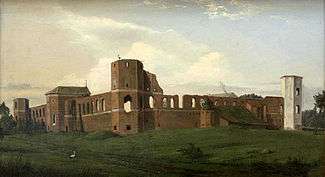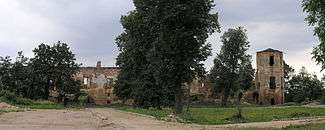Halshany Castle


Halshany or Holszany Castle (Belarusian: Гальшанскі замак, Lithuanian: Alšėnų pilis, Polish: Zamek holszański) is the ruined residence of the Sapieha magnate family in Halshany, Hrodna Voblast, Belarus and was the seat of the one of the largest land estates in the Grand Duchy of Lithuania. Paweł Stefan Sapieha commissioned its construction and it was erected circa 1610 to replace the older castle, built by of the Holszanski princely family, of whom Sapiehas were descendants and heirs.
Also known as the Black Castle (although it is built of red brick), the residence formerly rivaled Mir Castle as the most elegant private château of the Grand Duchy of Lithuania. The name Black Castle in fact originally applies to a fictional building from a book by Uladzimir Karatkievich, which was loosely based on Halshany Castle.
The castle and the surrounding estates were devastated, robbed and looted, twice: by the invading Swedes troops during the Deluge (history) and during the Great Northern War in 1704. Due to financial stress experienced by the Sapiehas in the wake of the Domestic War and ongoing Great Northern War, the castle had never been fully restored.
Later during the 18th century the castle with its estate diminished by creditors passed to the Żaba family, to be sold to the Korsak family with the estate further diminished by the creditors. The last Polish landlords. the Korsaks, sold, in the last quarter of the 19th century, the castle to a Russian landlord, Gorbanyov, who had the castles' towers pulled down in 1880, but in 1880s, according to the Geographical Dictionary of the Kingdom of Poland, there were still 2 floors occupied with some of the wall paintings visible.
Currently, the castle continues to crumble away. An annual tournament is held near its walls each summer.
References
- М.А. Ткачоў, I.М. Чарняўскі. Збор помнікаў гісторыі і культуры Беларусі: Гродзенская вобласць. Minsk, 1986.
- Słownik geograficzny Królestwa Polskiego i innych krajów słowiańskich. (Geographical Dictionary of the Kingdom of Poland), Warszawa : nakł. Filipa Sulimierskiego i Władysława Walewskiego, 1880-1914, Volume III (1882), p. 102-103.
External links
| Wikimedia Commons has media related to Halšany Castle. |
- Halshany Castle page at radzima.org
- Halshany Castle page at globus.tut.by (Russian)
- International Festival Golshany Castle 2010 (video) on the Official Website of Belarus
- Charity account opened for Halshany Castle (Russian)
Coordinates: 54°15′05″N 26°01′13″E / 54.251264°N 26.020292°E